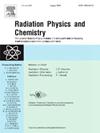模拟质子在硅和二氧化硅中造成的位移损伤
IF 2.8
3区 物理与天体物理
Q3 CHEMISTRY, PHYSICAL
引用次数: 0
摘要
如今,Si & SiO2 已成为半导体器件中应用最广泛的材料,如 CPU 和其他各种集成电路芯片,在航空航天电子系统中也有应用,同时质子是宇宙射线的重要组成部分,会对 Si & SiO2 造成位移损伤。因此,研究质子对 Si & SiO2 造成的位移损伤十分必要。本文采用 Geant4 软件模拟了不同能量的入射质子在 Si & SiO2 中的迁移过程。模拟结果表明,入射质子在Si & SiO2中产生的原叩原子(PKA)在较低能量范围内占优势,其空间分布沿入射质子方向逐渐增大,PKA的散射角约为90°,近似于高斯分布。而在较低的能量范围内,弹性散射产生的 28Si 和 16O 是 Si & SiO2 辐射损伤的主要来源。但随着质子能量的增加,核非弹性散射的贡献变得越来越重要,但诱导损伤的总体水平逐渐降低。同时,模拟结果表明,随着材料深度的增加,非电离能量损耗(NIEL)逐渐增加,弹性散射引起的非电离能量损耗在材料表层附近较高,而核非弹性散射引起的非电离能量损耗在材料表层附近也较高。本文的模拟结果可为研究质子辐照造成的 Si & SiO2 位移损伤提供有用的数据和理论指导。本文章由计算机程序翻译,如有差异,请以英文原文为准。
Simulation of displacement damage in Si & SiO2 caused by protons
Nowadays Si & SiO2 have been the most widely used materials in semiconductor devices as CPU and other various integrated circuit chips, utilized in aerospace electronic systems, and at the same time protons are important components of cosmic rays that can cause displacement damage in Si & SiO2 . Therefore, it is essential to study the displacement damage of Si & SiO2 caused by protons. The software of Geant4 is adopted in this paper, to simulate transportation process of incident protons with different energy in Si & SiO2 . The simulation results indicates that primary knock-on atom (PKA) generated by incident proton in Si & SiO2 is predominant in lower energy range, its spatial distribution increases gradually along the direction of incident proton, and the scattering angle of the PKA is about 90°, following a Gaussian distribution approximately. And in lower energy range, 28 Si and 16 O generated by elastic scattering are a primary source of radiation damage in Si & SiO2 . But as the proton energy increases, the contribution of nuclear inelastic scattering becomes more and more important, but the overall level of induced damage diminishes gradually. Meanwhile, the simulation results indicate that with increasing depth of the material, the non-ionizing energy loss (NIEL) increases gradually, and NIEL caused by elastic scattering is higher near the surface layer of the materials, and as for NIEL caused by nuclear inelastic scattering is also higher near the surface layer of the materials. The simulation results in this paper can provide useful data and theoretical guidance for study on Si & SiO2 displacement damage caused by proton irradiation.
求助全文
通过发布文献求助,成功后即可免费获取论文全文。
去求助
来源期刊

Radiation Physics and Chemistry
化学-核科学技术
CiteScore
5.60
自引率
17.20%
发文量
574
审稿时长
12 weeks
期刊介绍:
Radiation Physics and Chemistry is a multidisciplinary journal that provides a medium for publication of substantial and original papers, reviews, and short communications which focus on research and developments involving ionizing radiation in radiation physics, radiation chemistry and radiation processing.
The journal aims to publish papers with significance to an international audience, containing substantial novelty and scientific impact. The Editors reserve the rights to reject, with or without external review, papers that do not meet these criteria. This could include papers that are very similar to previous publications, only with changed target substrates, employed materials, analyzed sites and experimental methods, report results without presenting new insights and/or hypothesis testing, or do not focus on the radiation effects.
 求助内容:
求助内容: 应助结果提醒方式:
应助结果提醒方式:


